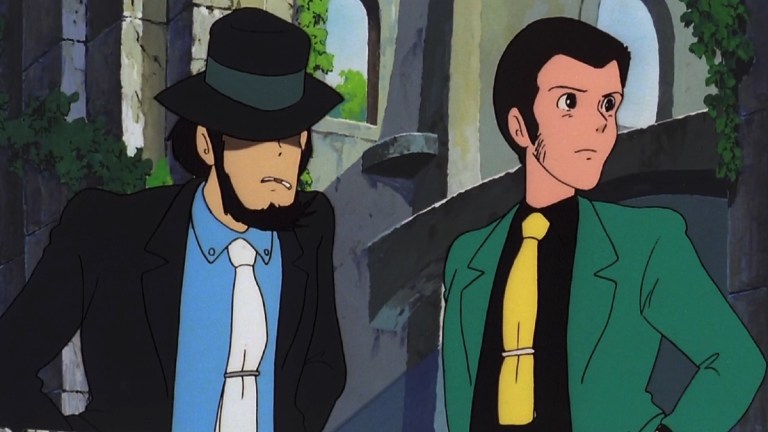From Lupin III to Inspector Gadget: Examining the Heirs of Arsène Lupin
Netflix’s Lupin presents Assane Diop, who along with some notable company, is the spiritual successor to famed gentleman thief Arsène Lupin.

This piece contains spoilers for Netflix’s Lupin.
As Arsène Lupin, the gentleman thief created by Maurice Leblanc in 1905, is a renowned master of disguise, it is fitting that he has inspired a number of literary characters to take up his mantle. Arguably the most recognizable riff is Lupin III, a copyright-infringing, quasi-canonical descendant by way of Japanese manga and anime. Yet it wasn’t until Netflix’s new French mystery comedy-drama series Lupin—which reinvented the source material through Omar Sy’s Lupin and the lenses of immigration, racism, and fandom—that readers and viewers have truly been challenged to consider what it means to inherit, whether through blood or through books, an iconic character’s legacy. Consider this a field guide to the many different Arsène Lupins.
What is immediately intriguing about both Lupins is that neither is as white as the top-hatted, monocled thief that Leblanc created over a century ago. Assane Diop (Sy), the charismatic lead of George Kay’s Lupin, is a Senegalese immigrant whose father Babakar (Fargass Assandé) brought him to Paris for a better life. The lethal mix of elitism and systemic racism that they encounter via Babakar’s employers, the Pellegrini family, are what shape young Assane’s life into a revenge narrative, but also become tools in his career as a gentleman thief. Yet even Lupin III, created in 1967 by manga artist Monkey Punch (a.k.a. Kazuhito Katō), is introduced as the French-Japanese grandson of Leblanc’s Arsène Lupin. In the Lupin the Third Part II episode “The Southern Cross Looked Like Diamonds,” which concerns Japanese casualties of the Pacific War, Lupin discusses his dual heritage. Both adaptations add texture to their Lupins’ stories by not allowing them to move through society quite as smoothly as the original French thief.
That said, Monkey Punch’s Lupin III certainly benefits from a fair amount of family legacy by carrying on his grandfather’s and father’s reputation as a world-renowned thief, marksman, master of disguise, womanizer—you name it. He’s almost more of a reincarnation of the original than a descendant, with the only real change being the shift in period from the early 20th century to the swingin’ sixties. Monkey Punch also drew from Lupin III’s contemporary James Bond to enhance some of those darker and more adult aspects in the manga, while basing Lupin’s on-again, off-again romance with bombshell spy Fujiko Mine on D’Artagnan and Milady de Winter’s relationship from Alexandre Dumas’ The Three Musketeers.
According to a 1995 issue of Manga Mania, Monkey Punch had initially considered keeping the blood connection a bit more under wraps, having not obtained the legal rights from Leblanc’s estate, but was convinced to embrace the Arsène Lupin connections. While Monkey Punch’s adoption of the Lupin persona wasn’t kosher by copyright standards, it was also very much in the spirit of the character—asking for forgiveness rather than permission—as well as the creator himself: Leblanc borrowed Sherlock Holmes for a few Lupin adventures before Sir Arthur Conan Doyle realized, and only then changed the detective’s name to “Herlock Sholmes” for subsequent showdowns. Still, it did eventually backfire for him, though it also led to, fascinatingly, beloved animated character Inspector Gadget (more on that later).
Perhaps the most beloved iteration of Lupin III is in Hayao Miyazaki’s 1979 film The Castle of Cagliostro. Monkey Punch’s manga cast Lupin III as a rather unsympathetic master thief: callous about his victims, a caddish ladies’ man who often harassed women he saw as little more than sex objects. While the anime quickly established a moral code—stealing from rich people who either deserved it or would not overly suffer for it—it was Miyazaki’s film that gave Lupin III real heart. In rescuing princess bride Clarisse from a Gothic marriage, he displays a surprising sense of chivalry, especially when the plucky girl wants to be his sidekick. Lupin’s silent agony over turning her down lends the otherwise carefree heist film a shocking touch of melancholy, and lays the groundwork for a more well-rounded Lupin III in future outings.
The Lupin III bloodline has extended several generations into the future, though none of these descendants made much of an impact beyond their respective adventures. First there was Lupin III Jr. (yes, that’s his name), the son of Lupin III and Fujiko, who only ever existed in the manga. Elusiveness of the Fog, the nineteenth Lupin III TV special, uses a time machine to jump ahead to 2883 and glimpse Lupin XXXIII, a.k.a. Lupin the 33rd, identical to his green-jacketed ancestor. He gets three whole lines and mostly seems like an excuse to show that thirty generations later, little about the iconic thief has changed.
In between those two there was Lupin the Eighth, would-be star of a 1982 spinoff created in collaboration between Lupin III studio TMS Entertainment and French-American studio DiC Entertainment. The Lupin VIII series would have jumped a conservative five generations ahead, with the familiar crew’s great-great-great-great-great-grandchildren carrying on the same names, traits, and rivalries and romantic entanglements. But when the Leblanc estate got wind of this Japanese/French collaboration showing up on their continent, they put the kibosh on the project; only the pilot was animated, and was shut down before vocals had been recorded.
Because TMS and DiC had already lost their investment, they scrambled to come up with a replacement for the timeslot. And so Inspector Gadget was created, with the trenchcoat-clad cyborg bumbling his way into viewers’ hearts. Despite his complete lack of suaveness compared to any version of Lupin, you could say that, in terms of staying power, Gadget was Lupin III’s true successor.
Yet while Lupin III had every familial and financial resource at his disposal to continue his grandfather’s and father’s work, everything Assane Diop needs to know he learns from a book. The Arsène Lupin books, which Babakar gifts him right before he is framed for stealing the priceless Queen’s Necklace from the Pellegrinis. Babakar’s arrest, guilty plea, and prison suicide leave Assane burdened with a strange inheritance of misfortune, words, and blood money—as Madame Pellegrini (Nicole Garcia) pays for fancy schooling he otherwise would not have been able to afford. Attending a prestigious academy is where he forges friendships with fellow morally gray criminal Benjamin Ferel (Antoine Gouy) and his eventual partner Claire (Ludivine Sagnier) and learns how to code-switch among his peers.
Presumably, that upbringing creates the scaffolding of connections that allows him to move through high society, but his wealth and prestige in adulthood is all due to Arsène Lupin. Assane studies those books like religious texts, like instruction manuals, like the last connection to his late father. His obsessive fandom provides him the blueprints for foolproof heists that he enhances with his own experiences at playing with disguise. Though he does later employ prosthetics for his appearance as Twitter user Salvator, for the most part Assane doesn’t obscure his face. Instead, he trusts in his marks’ implicit racial biases that they will buy him as a deadbeat dad and immigrant janitor Luis Perenna, then not blink twice when staring him in the face as millionaire Paul Sernine in the course of the same evening. In prison, he literally counts on a white guard’s inability to differentiate between two black men to switch places with a prisoner.
Assane also continues his father’s tradition of gifting the Arsène Lupin books to his own son for his 14th birthday: Raoul (Etan Simon), French-born, mixed-race and equally enamored of the gentleman thief’s adventures. While it’s unlikely that Assane wants his son to make the same dangerous enemies, he clearly wants Raoul to see himself in the character—and to see his father, who understandably has difficulty showing his true self to anyone.
This by-the-book adaptation (Arsène Lupin entered the public domain in 2012) engages with the notion that anyone can embody an iconic character—that their skin color or class upbringing doesn’t have to match the original, that they don’t have to be a blood relation to inherit a persona. For all that Lupin III exists in his own right and will endure as a classic franchise, Assane Diop’s Lupin may be the truer heir to the gentleman thief’s legacy.
Lupin is available to stream now on Netflix.
Subscribe to Den of Geek magazine for FREE right here!

